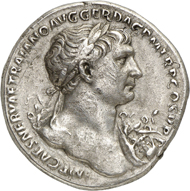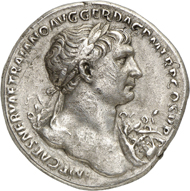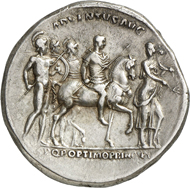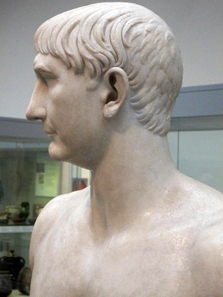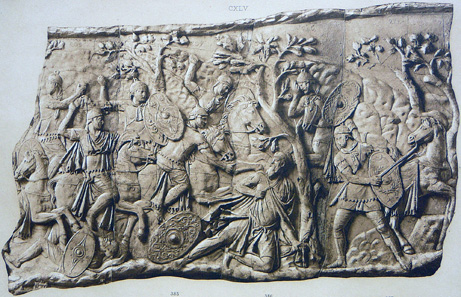TRAIANUS – OPTIMUS PRINCEPS, DACICVS
Not many specimens of the series of medallions that Trajan had minted on the occasion of his victory over the Dacians have survived. In his groundbreaking study (Peter Franz Mittag, Römische Medaillons. Caesar bis Hadrian. Franz Steiner Verlag, Stuttgart, 2010), Peter Mittag knows of only three reverse dies. The first one is attested by two bronze medallions, while in silver there are at least four specimens from two dies in total. Now, the silver medallions are enriched by another example, made from a hitherto unknown, fourth, die.
Trajan. Medallion, 106-107, Rome. Obv. IMP CAES NERVAE TRAIANO AVG GER DAC P M TR P COS V P P laureate bust and aegis on l. shoulder r. Rev. ADVENTVS AVG / SPQR OPTIMO PRINCIPI Trajan in military garments riding with lance r., female deity (Felicitas?) with cornucopia and caduceus(?) in front, helmeted, naked Mars with lance and round shield behind, two soldiers in the background. RIC -. C. 1var. Strack 118var. BMC 257var. MIR 259var. Mittag p. 138 Tra 6. In Swiss private collection since the 1970s, acquired afterwards in 1984. Unique specimen. Light toning, tiny scratches on both obverse and reverse, about extremely fine. Estimate: 150,000 euros. Ex Gorny & Mosch 224 (13 October, 2014) lot 511.
This is of high numismatic interest. We are now in the position to link four medallion dies to one single occasion. Although the actual durability of a coining die continues to be a matter of dispute, it is safe to assume that at least 4,000 medallions were made from these four dies.
This is significant insofar as the exact purpose of these medallions is still controversial. We have no literary sources about that. Numismatists usually interpret the medallions as imperial gift for a select circle in some festive context. But who belonged to that circle? The most intimate friends of the emperor who accompanied him everywhere he went and advised him? The supreme command? All of the officers?
The new die can provide us with an important clue as to a possible answer to this question: when one single occasion justified the production of at least as many as four dies then the circle of recipients most likely was not too small.
Portrait of Trajan. British Museum / London. Photo: UK.
This is in accordance with the historical context. Trajan used this imperial gift to remind as many members of the ruling classes as possible of his great victory over the Dacians. After all, Trajan himself did not come from an influential Rome-based family. It was exclusively military successes he owed his position to. And these successes had to be brought home to his target audience over and over: in 98/99, Trajan traveled north in order to secure the borders. An additional element was the revision of all contracts with the clientele kings, and Trajan deemed the contract Domitian had negotiated with Decebalus significantly too expensive due to the high subsidies Domitian had granted. So Trajan wanted to negotiate. But Decebalus saw no reason at all to change any stipulations of the contract.
At some point at the beginning of A. D. 100, Trajan must have decided to revise the contract by different means. Naturally, that called for a better justification, but there was always something like minor violations of frontiers happening. These violations came in handy in that situation and were then taken as cause of war. Trajan concentrated seven entire legions, plus greater parts of another three legions, smaller units from Britannia and the East, numerous auxiliary troops and large parts of the Danube fleet. By that, he had the biggest army at his disposal that Rome had ever sent to war. Trajan himself traveled to the front to command the forces. That he did efficiently. Although Decebalus was a serious enemy that even managed to bring the war into the Roman province, Trajan prevailed in the end. Decebalus himself went down on his knees before Trajan and begged for peace. Trajan showed mercy. Decebalus was left in his kingdom but had to accept harsh conditions: the Dacians had to hand over their fortifications and their weapons. They were ordered to reconcile their foreign policy with Rome in the future. Additionally, parts of Dacia remained under Roman control. It was a huge success for the Romans. Trajan adopted the victory title of Dacicus and celebrated a triumph.
Nobody in Rome anticipated that such an insignificant clientele king like Decebalus could possibly be unhappy with the outcome of events. Decebalus, however, tried to forge a coalition between the neighboring peoples. He even contacted the Parthians. That of course did not go unnoticed by Rome.
Death of Decebalus. Detail of the Trajan’s Column after Conrad Cichorius (1863-1932), pl. XVI. / Wikipedia.
And so Trajan decided to fight the Dacians in a second war – Decebalus did not stand a chance. Trajan captured the capital city of Sarmizegetusa and seized the huge treasure while the defeated Dacian king killed himself.
Trajan did not return to Rome immediately afterwards. On the contrary, he organized the conversion of the rich mining area into a province. The triumph was celebrated as late as the summer of A. D. 107.
This was probably the occasion on which the medallion was minted and distributed that is currently being offered for sale by Gorny & Mosch in auction sale #224, to be conducted on 13 October, 2014.The estimate of this historically and numismatically intriguing piece is 150,000 euros.
You can find the complete auction catalogue on the Gorny & Mosch website.




